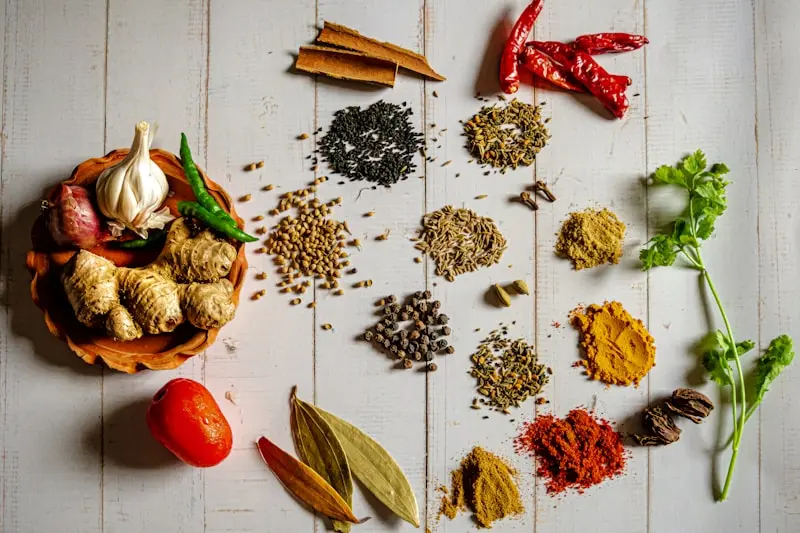
Spices are aromatic components derived from plants, packed with beneficial substances that positively impact health and strengthen the immune system. Beyond their health benefits, spices add various nuances to food, enhancing its flavor, making any dish fragrant, and stimulating the appetite. Today, no home cook can do without them. Let’s take a closer look at some popular spices.
Black Ground Pepper
Perhaps the most popular seasoning, black ground pepper is added to meat, fish, pâtés, and sausages. It’s also used to season salads, eggs, cottage cheese, various vegetable dishes, and soups. Typically, black ground pepper is added at the end of cooking.
Whole Black Pepper
Whole black pepper is another widely used spice. It’s added to soups, broths, sauces, and meat, vegetable, and fish dishes. Whole black pepper is usually added at the beginning of cooking.
White Pepper
White pepper is used in smaller amounts than black pepper. It complements the flavor of white sauces, cheeses, boiled meat, and fish beautifully. It enhances the taste of soups, salads, vegetable dishes, eggs, as well as pastries and juices. Like black pepper, white pepper is added at the end of cooking.
Red Pepper
Red pepper is known for its ability to boost the immune system and normalize digestion. It is a staple spice in Hungarian, Mexican, and Indian cuisines. It’s used in meat, fish, and poultry dishes, as well as in soups, vegetable dishes, salads, and cottage cheese. Red pepper can also be used to color sauces and dishes made with eggs, rice, and poultry.
Allspice
Allspice has a spicy aroma reminiscent of a blend of pepper, cloves, cinnamon, and nutmeg. It has dietary benefits and stimulates the appetite. It’s used to season meat, fish, soups, sauces, marinades, and pickles.
Chili
Chili is used to spice up meat dishes, hot sauces, and vegetable dishes, as well as goulash, poultry, fish, and seafood. It is the hottest spice used in cooking today and is characteristic of Mexican cuisine.
Curry
Curry is most often used to enhance the flavor of meat dishes, whether made with poultry, pork, or lamb, as well as vegetable dishes, rice, and sauces. The curry blend typically includes turmeric, fenugreek, coriander, nutmeg, black pepper, chili, garlic, cardamom, cloves, cumin, cinnamon, ginger, monosodium glutamate (flavor enhancer), and salt.
Cinnamon
Cinnamon is used to season fruit soups, compotes, jellies, creams, pastries, cottage cheese, puddings, and dairy drinks. It’s an essential addition to sweet rice dishes, baked apples, mulled wine, and punch. In small amounts, cinnamon is also used to season goulash, lamb dishes, boiled fish, and ham. It’s added to dishes a few minutes before cooking is complete.
Khmeli-Suneli
Khmeli-Suneli is used in the preparation of meat and vegetable dishes. This spice blend typically includes coriander, basil, savory, marjoram, hot red pepper, bay leaf, dried vegetables (such as garlic, parsley, celery leaves, onions, etc.), and salt.
Marjoram
Marjoram is a spice native to Mediterranean countries. It’s used in making homemade sausages, meat dishes, sauces, various fillings, pâtés, vegetables, and soups, as well as mushroom dishes. Marjoram is often combined with thyme, enhancing the flavor of dishes and allowing for reduced salt usage. It’s used differently depending on the dish: for meat and sausage, it’s added before frying or boiling, while for other dishes, it’s added at the end of cooking.
Oregano
Oregano is a key spice in Italian, Spanish, and Mexican cuisines. It’s added to vegetables, cottage cheese, fish, and crab dishes. It’s also used in meat dishes, sauces, and hearty soups. Oregano is a primary seasoning for pizza and spaghetti and pairs wonderfully with basil, marjoram, thyme, and pepper.
Basil
Basil is one of the most popular spices in Italian cuisine. It’s used for all kinds of vegetables, particularly in salads and dishes featuring tomatoes, cabbage, spinach, beans, and peas. Basil is a fantastic spice for soups, fish dishes, poultry, pork, salads, cottage cheese, eggs, omelets, crab salads, and green sauces. It pairs well with garlic and, along with rosemary, serves as a great salt substitute. Basil should be added to dishes at the end of cooking.
Bay Leaf
Bay leaves are widely used in cooking. They enhance the flavor of soups, meat dishes, sauces, goulash, boiled fish, mushrooms, and dishes made with crayfish and crabs. Bay leaves are an essential seasoning for pickling vegetables. This spice softens the taste of salty dishes, awakening the appetite and aiding digestion. Bay leaves are typically used whole, though sometimes they are ground into powder.
Ginger
Ginger is added to dough, puddings, compotes, cucumbers, marmalade, jellies, and fruits. It imparts a subtle flavor to various meat soups, vegetable soups, fruit soups, sauces, game dishes, and all types of rice dishes. Ginger is also added to cheeses, meat, fish, and vegetables along with salt.
Cardamom
Cardamom adds a unique flavor to cookies, various pies, gingerbread, pastries, compotes, and fruit dishes. It can also be added to coffee. Cardamom enhances the flavor of soups, sauces, gravies, fish and meat dishes, pilafs, and pâtés. It’s also used in sausages and ham.
Coriander
Coriander is a very popular spice worldwide. It boosts liver function and improves appetite. Coriander is used both as a spice and as tea. It’s added during canning and also for baking.
Thyme
Thyme is used when pickling cucumbers and tomatoes, along with dill, and is great for potato and tomato salads, soups, borscht, and cabbage soup. Thyme pairs wonderfully with stewed meat, especially lamb, steaks, rice, and pasta, as well as egg and chicken dishes. As a spice, thyme is mainly used dried.
